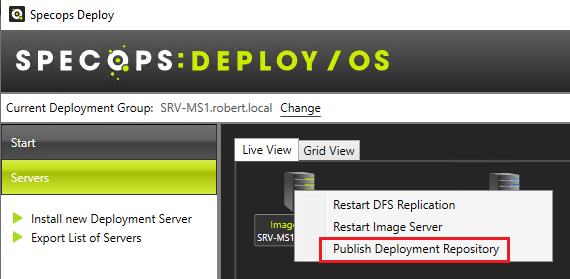Migrate Specops Deploy OS to a new server
Here follow instructions for a Specops Deploy OS migration to a new server. This is a complex process and our advice Is to be careful and not rush through the steps. We also offer consultancy if you want a Specops product specialist to carry out the migration for you.
Pre-requirements
Make sure to remember this information, it will be configured when you run the Specops installation on the new server.
On your old Image server: Open the Bootstrap.ini file and check what service account and password being used. The file Is located here:
D:, E: or F:\Specops\Deploy\DeploymentRepository\Control
In the Bootstrap.ini file:
UserID=YourServiceAccount
UserPassword=YourServiceAccountPassword
Open the registry and check which scope is selected. The registry item is called Scope and is located here: HKLM\software\specopssoft\Specops deploy\Image server\domains\yourdomain.name
The Migration of Specops Deploy OS
1. Copy the Specops folder from the old image server to the new image server. It will most likely be stored in the root on D:, E: or F:.
2. Copy the xml file SpecopsDeployDriverMetaData from the old image server (located in C:\ProgramData\Specopssoft\Image Server\) to the new servers C:\Temp folder. This file will be copied to the correct location later.
3. On the new server: Delete the junction point called rep. It’s a shortcut folder located in the C:\Specops folder.
4. On the new server: Install the latest MDT (Microsoft Deployment Toolkit) and ADK (Assessment and Deployment Kit).
5. Restart the new Server (Important!)
6. Install Specops Deploy OS on the new server.
The latest version can be downloaded here: https://specopssoft.com/support/en/deploy-os/download.htm
(don’t forget the ADK 2004 fix later on, a link to instructions can be found at the download section).
Installation guide: https://specopssoft.com/support/en/deploy-os/installation.htm
During the installation select the correct drive where you copied your Specops folder (Step 1). The Specops folder needs to be in place on the new server before you run the Specops Deploy OS setup.
Make sure you also have the Specops Deploy 7.x license key file available. The Specops Deploy OS admin tool on the new server will ask for it.
7. On the new Image server: Copy the xml file SpecopsDeployDriverMetaData from C:\Temp (step 2) to the C:\Programdata\Specopssoft\Image Server folder. This will make sure that the old driver folder and make/model/OS structure still will be intact and properly migrated.
8. On the new Image server: Restart the Specops Deploy Image Server service or restart the server.
9. On the new Image server: In the Specops Deploy OS admin tool, install the new deployment server/servers.
10. On the new Image server: publish the changes.
Usually an orange colored bar turns up in the admin tool when there are unpublished changes, click on the bar to start the publish. You can also publish manually by right-clicking the Image server icon and select “Publish Deployment Repository”.

11. When the publish is finished, open Windows Deployment Services (WDS) and check that the x86 and the x64 boot images are visible.

12. In Group Policy Management: Edit your Specops Deploy OS configured group policies and change Deployment Group to the new server (Computer Configuration/Policies/Software Settings/Specops Deploy / OS).
13. On the old Image server: In the Specops Deploy OS admin tool, uninstall all the deployment servers.
14. On the old Image server: In “Programs and features”: Uninstall the Specops Deploy Image server service (or disable the image server service).
15. In Active Directory Users & Computers: Locate the server object for your old Image server. Delete its leaf objects (service connection points) called Specops Deploy Deployment Server and Specops Deploy Image server.

16. Uninstall or disable the Windows Deployment Server (WDS) on the old server, otherwise you will end up with two servers answering on PXE broadcasts in your network.
17. If the new Deployment server (servers) has a new IP address and IP helpers (or DHCP) has been configured. Make sure to change to the new deployment server IP address so PXE broadcasts from clients are being directed to the new deployment server.
